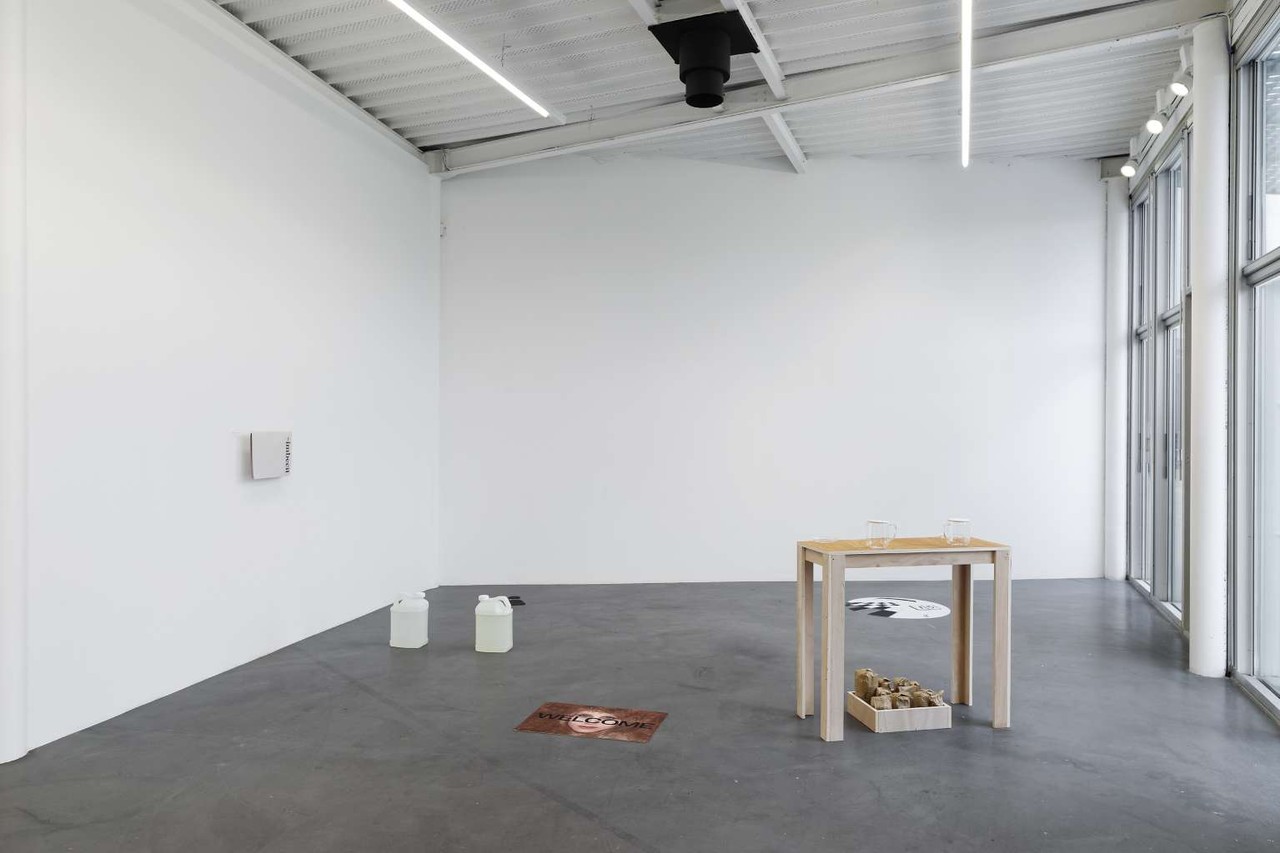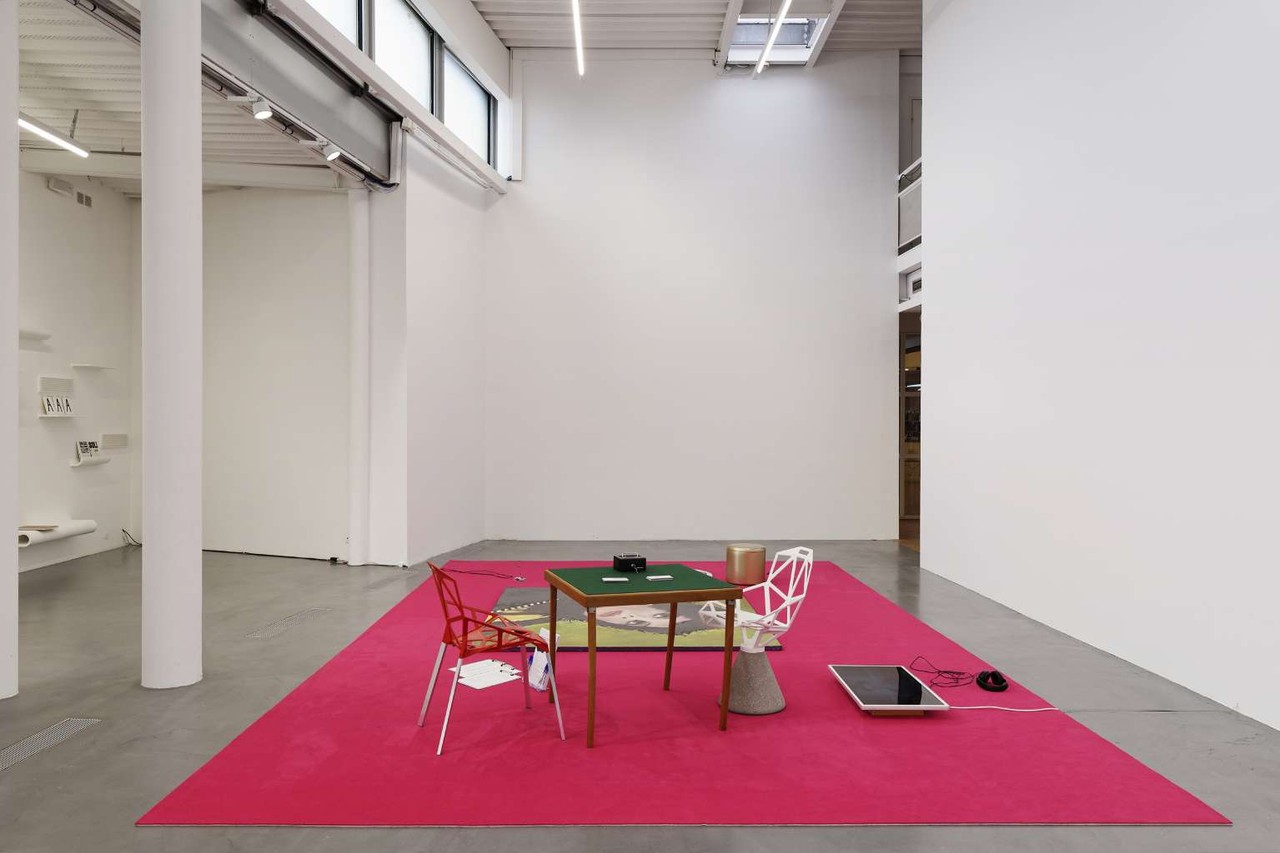Jump
19 Nov 2016 - 22 Jan 2017
JUMP
19 November 2016 — 22 January 2017
Curator: Céline Poulin
With: Julie Béna; Jean-Luc Blanc; Aleksandra Domanović; Zackary Drucker; Jean-Pascal Flavien; Christophe Lemaitre; Géraldine Longueville; Teresa Margolles; Fabio Morais; Christodoulos Panayiotou; Sean Raspet; Dennis Rudolph; The Big Conversation Space; and a special invitation to curator Agnès Violeau
To jump (as in the title of the show) is to pass from one place to another, from one subjectivity to another, from an object to its possible use (or not).
JUMP, a special presentation-installation devised by the artist Jean-Pascal Flavien, aims to connect the two sides of a single entity — the galleries of the art center and its digital space, offering both of them a reciprocal yet uncertain translation. There are as many kinds of jumps as there are combinations of possible elements.
The works of the featured artists invited to populate Flavien’s installation play on the ambiguity of their status, be they objects of connection or conflict, personal or utilitarian artifacts, ambivalent forms, or passages between different realities. JUMP experiments with the way pieces of art function, work in the day-to-day world, seek to redefine traditional categories and uses, and radically or surreptitiously sow confusion in "common sense". Mutating throughout its run, JUMP reflects the use of the space while putting the shifting identity of the venue in perspective.
As Jean-Pascal Flavien writes in the statement that produced the installation:
"What is important... is the passages of one space to another / These passages (jumps) are translations, shifts / The passages are semantic and formal. Here it’s sometimes the same thing / There are always things lost, formal and semantic, during this passage (lost information) / Rule: the worse a translation or transposition is (more loss of information), the more the passage is perceptible, and the new space appears as it is..."
The surfaces refer to each other, the worlds exist. The lens of the cameras project colorful shapes on the floor. The works are installed there and, if they want to, can evolve there as well. Christodoulos Panayiotou’s pink window and Teresa Margolles’ floor [1] evince that time that passes inexorably or on occasion is suddenly interrupted. It is a time that is subject to variations and whose impact we must learn to verify at every instant, just as Christophe Lemaitre reminds us with a new element in his collection of objects that can be used without having to touch them. The thread plays out and always leads us to new stories and questions of personal identity. Zackary Drucker’s face calls out to us from a Welcome. It is important that each person finds his or her spot, led by the mouth thanks to Géraldine Longueville’s elixirs, which are nothing more than guides taking the form of fluids. At the same time, bodies that may or may not be alive will be moving about the venue, puppets springing from the stories elaborated by Julie Béna or Fabio Morais. Or maybe it’s the endlessly changing faces of Jean-Luc Blanc, their alterability alluding to the impermanence of the self. "It’s only here, in this unintegrated state of the personality, that that which we describe as creative can appear", Donald W. Winnicott writes. To achieve that, however, what is needed is "a desultory formless functioning, or perhaps... rudimentary playing, as if in a neutral zone". Is the zone here neutral or carefully marked out? What gloss and what misunderstandings permeate us, Agnes Violeau asks. The Big Conversation Space invites anyone who wishes to to hold forth on power, fear, and information with its operators, whether on site at the center or on the web. Because it is always language that forms the structure in which we move. The machinery we are stakeholders in produces its own vocabulary. Some choose to follow its rules, to sublimate them to the point of absurdity, like the fascinating glacial forms created by Sean Raspet, or Dennis Rudolph’s outrageous ideas for television. With Aleksandra Domanović, beauty and politics collide, referencing the place occupied by man and the artist, who describe to the world its own face. "This [creativity] if reflected back, but only if reflected back... eventually this in summation makes the individual to be, to be found."[2]
Céline Poulin
[1] Long-term works for CAC Brétigny, the outcome of the Projet Phalanstère. Active from 2003 to 2014 under the leadership of Pierre Bal-Blanc at CAC Brétigny, this project involved artists realizing on-site works of art meant to enlarge and enrich the art center’s architecture while responding to the needs of those who use our institution. A catalogue detailing the project is slated for publication by éditions Work Method.
[2] Donald W. Winnicott, Playing and Reality (1971), New York: Routledge, 2005, 86.
19 November 2016 — 22 January 2017
Curator: Céline Poulin
With: Julie Béna; Jean-Luc Blanc; Aleksandra Domanović; Zackary Drucker; Jean-Pascal Flavien; Christophe Lemaitre; Géraldine Longueville; Teresa Margolles; Fabio Morais; Christodoulos Panayiotou; Sean Raspet; Dennis Rudolph; The Big Conversation Space; and a special invitation to curator Agnès Violeau
To jump (as in the title of the show) is to pass from one place to another, from one subjectivity to another, from an object to its possible use (or not).
JUMP, a special presentation-installation devised by the artist Jean-Pascal Flavien, aims to connect the two sides of a single entity — the galleries of the art center and its digital space, offering both of them a reciprocal yet uncertain translation. There are as many kinds of jumps as there are combinations of possible elements.
The works of the featured artists invited to populate Flavien’s installation play on the ambiguity of their status, be they objects of connection or conflict, personal or utilitarian artifacts, ambivalent forms, or passages between different realities. JUMP experiments with the way pieces of art function, work in the day-to-day world, seek to redefine traditional categories and uses, and radically or surreptitiously sow confusion in "common sense". Mutating throughout its run, JUMP reflects the use of the space while putting the shifting identity of the venue in perspective.
As Jean-Pascal Flavien writes in the statement that produced the installation:
"What is important... is the passages of one space to another / These passages (jumps) are translations, shifts / The passages are semantic and formal. Here it’s sometimes the same thing / There are always things lost, formal and semantic, during this passage (lost information) / Rule: the worse a translation or transposition is (more loss of information), the more the passage is perceptible, and the new space appears as it is..."
The surfaces refer to each other, the worlds exist. The lens of the cameras project colorful shapes on the floor. The works are installed there and, if they want to, can evolve there as well. Christodoulos Panayiotou’s pink window and Teresa Margolles’ floor [1] evince that time that passes inexorably or on occasion is suddenly interrupted. It is a time that is subject to variations and whose impact we must learn to verify at every instant, just as Christophe Lemaitre reminds us with a new element in his collection of objects that can be used without having to touch them. The thread plays out and always leads us to new stories and questions of personal identity. Zackary Drucker’s face calls out to us from a Welcome. It is important that each person finds his or her spot, led by the mouth thanks to Géraldine Longueville’s elixirs, which are nothing more than guides taking the form of fluids. At the same time, bodies that may or may not be alive will be moving about the venue, puppets springing from the stories elaborated by Julie Béna or Fabio Morais. Or maybe it’s the endlessly changing faces of Jean-Luc Blanc, their alterability alluding to the impermanence of the self. "It’s only here, in this unintegrated state of the personality, that that which we describe as creative can appear", Donald W. Winnicott writes. To achieve that, however, what is needed is "a desultory formless functioning, or perhaps... rudimentary playing, as if in a neutral zone". Is the zone here neutral or carefully marked out? What gloss and what misunderstandings permeate us, Agnes Violeau asks. The Big Conversation Space invites anyone who wishes to to hold forth on power, fear, and information with its operators, whether on site at the center or on the web. Because it is always language that forms the structure in which we move. The machinery we are stakeholders in produces its own vocabulary. Some choose to follow its rules, to sublimate them to the point of absurdity, like the fascinating glacial forms created by Sean Raspet, or Dennis Rudolph’s outrageous ideas for television. With Aleksandra Domanović, beauty and politics collide, referencing the place occupied by man and the artist, who describe to the world its own face. "This [creativity] if reflected back, but only if reflected back... eventually this in summation makes the individual to be, to be found."[2]
Céline Poulin
[1] Long-term works for CAC Brétigny, the outcome of the Projet Phalanstère. Active from 2003 to 2014 under the leadership of Pierre Bal-Blanc at CAC Brétigny, this project involved artists realizing on-site works of art meant to enlarge and enrich the art center’s architecture while responding to the needs of those who use our institution. A catalogue detailing the project is slated for publication by éditions Work Method.
[2] Donald W. Winnicott, Playing and Reality (1971), New York: Routledge, 2005, 86.





